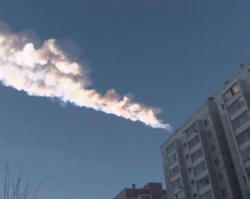|
 Chelyabinsk
Asteroid Crashed In Space Before Hitting Earth: Scientists Chelyabinsk
Asteroid Crashed In Space Before Hitting Earth: Scientists
 Send a link to a friend
Send a link to a friend
[May 24, 2014]
By Irene Klotz
CAPE CANAVERAL Fla. (Reuters) - An
asteroid that exploded last year over Chelyabinsk, Russia, leaving more
than 1,000 people injured by flying glass and debris, collided with
another asteroid before hitting Earth, new research by scientists shows.
|
|
 Analysis of a mineral called jadeite that was embedded in
fragments recovered after the explosion show that the asteroid's
parent body struck a larger asteroid at a relative speed of some
3,000 mph (4,800 kph). Analysis of a mineral called jadeite that was embedded in
fragments recovered after the explosion show that the asteroid's
parent body struck a larger asteroid at a relative speed of some
3,000 mph (4,800 kph).
"This impact might have separated the Chelyabinsk asteroid from its
parent body and delivered it to the Earth," lead researcher Shin
Ozawa, with the University of Tohoku in Japan, wrote in a paper
published this week in the journal Scientific Reports.
The discovery is expected to give scientists more insight into how
an asteroid may end up on a collision course with Earth. Scientists
suspect the collision happened about 290 million years ago.
Most of the 65-foot (20-meter) wide asteroid that blazed over
Chelyabinsk in southwestern Siberia on Feb. 15, 2013, was
incinerated in a bright fireball, the result of frictional heating
as it dropped through the atmosphere at 42,000 mph (67,600 kph). But
many small fragments survived.

The asteroid was traveling almost 60 times the speed of sound and
exploded about 18 miles (30 km) above ground with a force nearly 30
times as powerful as the atomic bomb dropped by the United States on
Hiroshima, Japan in 1945 in World War Two.
The blast over Chelyabinsk caused shock waves that destroyed
buildings and shattered windows. More than 1,000 people were injured
by flying debris.
Analysis of recovered Chelyabinsk meteorites revealed an unusual
form of jadeite entombed inside glassy materials known as shock
veins, which form after rock crashes, melts and re-solidifies.
Jadeite, which is one of the minerals in the gemstone jade, forms
only under extreme pressure and high temperature. The form of
jadeite found in the Chelyabinsk meteorites indicates that the
asteroid’s parent body hit another asteroid that was at least 492
feet (150 meters) in diameter.
[to top of second column] |

Scientists are still analyzing fragments of the asteroid and
calculating its precise path toward Earth.
In an email to Reuters, Ozawa described the Chelyabinsk meteorite as
"a unique sample.”
"It is a near-Earth object that actually hit the Earth, and its
trajectory was well-recorded,” Ozawa wrote.
The Chelyabinsk asteroid caused the second most powerful explosion
in recorded history. In 1908, a suspected asteroid exploded with a
force about 1,000 times more powerful than the Hiroshima atomic
bomb, leveling some 80 million trees over 772 square miles (2,000
square km) near Russia’s Podkamennaya Tunguska River in Siberia.
The first possible meteorites from the so-called Tunguska event were
recovered just last year. Results have not yet been published.
(Editing by Grant McCool)
[© 2014 Thomson Reuters. All rights
reserved.] Copyright 2014 Reuters. All rights reserved. This material may not be published,
broadcast, rewritten or redistributed.

 |